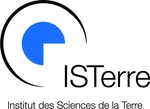PhD Position "Current deformation and groundwater reservoirs in the Jura mountains"
University Grenoble Alpes
The Institute of Earth Sciences (ISTerre, Grenoble) is a joint research unit of the CNRS, Grenoble-Alpes University, the University of Savoie Mont Blanc, the French National Research Institute for Development and the French institute of science and technology for transport, development and networks. ISTerre is affiliated to the Observatory of Earth Sciences and Astronomy of Grenoble, and to PAGE, a research center of Grenoble-Alpes University.
Organized in 10 research teams, the primary goal of our research unit is the physical and chemical study of the planet Earth through a combiniation of observations of natural objects, experimentation, and the modeling of complex processes.
ISTerre also supports observatory missions of solid Earth, is home to a centralized database, and maintains multiple national catalogues of geophysical instrumentation.
Chrono-environnement Besançon is a joint research unit led by CNRS (Centre National de la Recherche Scientifique) and UBFC (Université de Bourgogne Franche-Comté) and brings together archaeologists, ecologists and ecotoxicologists, geologists and hydrologists, microbiologists, virologists, mathematicians, historians, chemists, and physicists who have learned to work on common themes. The unit’s scientific project is guided by the goals of the international Future Earth initiative, which promotes the acquisition of knowledge necessary for sustainable global development.
Homepage: https://isterre.fr
Hydrological Sciences (HS)
Seismology (SM)
PhD thesis proposal (financed, start in September/October 2025):
“New insights into current deformation in the Jura and implications for groundwater reservoirs: seismological and geodetic measurements and use of accumulated databases”
Supervisors: Andrea Walpersdorf, Institute for Earth Sciences (ISTerre), Grenoble, and Julie Albaric, Chrono Environment, Besançon, France
The aim of this thesis project is to study active deformation in the Jura Arc (France-Switzerland border region), using recent geophysical data (GNSS and seismological data). One of the objectives is to distinguish between deformation of the sedimentary cover and that of the basement (‘thin skin’ or ‘thick skin’ deformation). The new data of the project will make it possible to estimate the slip rates of active faults, in particular the Vuache fault, in order to assess their contribution to the seismic hazard, particularly in sensitive areas such as the Bugey nuclear power plant. An exploratory part of the thesis examines the links between crustal deformation and groundwater reservoirs in the Jura massif, with a focus on the Fourbanne karstic aquifer, a multi-instrument site at the interface between several thematic Earth Science observatories. The aim is to study the link between hydrogeological variations, surface deformation and seismicity, thereby contributing to a better characterisation of water resources and seismic hazard in the region.
Candidates should ideally have an education in Earth Sciences or physics, and the capacity to interact efficiently with specialists of the different disciplines involved in this project. Autonomy and proactivity will be appreciated.
References:
Abi Nader, A., J. Albaric et al. (2023). Machine learning prediction of groundwater heights from passive seismic wavefield. Geophys. J. Int. (2023) 234, 1807–1818, https://doi.org/10.1093/gji/ggad160.
Almagro Vidal, C., et al. (2024). Crustal deformation and seismic velocity perturbations in the Alto Tiberina fault zone (Northern Apennines, Italy). J. Geophys. Res. (Solid Earth), 129, e2024JB029023. https://doi.org/10.1029/2024JB029023
Baer, M., et al. (1999). Earthquakes in Switzerland and surrounding regions during 1998. Eclog. Geol. Helv., 92/2, 265–273.
Baize, S., et al.., 2011. Contribution to the seismic hazard assessment of a slow active fault, the Vuache fault in the southern Molasse basin (France). Bulletin de la Société Géologique de France, 182 (4): 347–365, https://doi.org/10.2113/gssgfbull.182.4.347
Doubre C., et al., 2021. Seismotectonics in Northeastern France and neighboring regions. Comptes Rendus. Géoscience, Volume 353, no. S1, pp. 153-185. doi : 10.5802/crgeos.80. https://comptes-rendus.academie-sciences.fr/geoscience/articles/10.5802/crgeos.80/
Larroque C., S. Baize, J. Albaric, H. Jomard, J. Trévisan, M. Godano, M. Cushing, A. Deschamps, C. Sue, B. Delouis, B. Potin, F. Courboulex, M. Régnier, D. Rivet, D. Brunel, J. Chèze, X. Martin, C. Maron, and F. Peix, “Seismotectonics of southeast France: from the Jura mountains to Corsica,” Comptes Rendus. Géoscience, vol. 353, no. S1, pp. 105–151, 2021. https://doi.org/10.5802/crgeos.69
Rabin, M., Sue, C., Walpersdorf, A., Sakic, P., Albaric, J., & Fores, B. (2018). Present‐Day Deformations of the Jura Arc Inferred by GPS Surveying and Earthquake Focal Mechanisms. Tectonics, Vol. 37, Issue 10, pp. 3782-3804 DOI: 10.1029/2018TC005047.
Serpelloni, E., et al. (2018). Hydrologically induced karst deformation: Insights from GPS measurements in the Adria-Eurasia plate boundary zone. Journal of Geophysical Research: Solid Earth, 123, 4413–4430.
Silverii, F., et al., Transient crustal deformation from karst aquifers hydrology in the Apennines (Italy), Earth and Planetary Science Letters, 506:23-37, 2019. DOI: 10.1016/j.epsl.2018.10.019
Smeraglia et al. (2021). U–Pb dating of middle Eocene–Pliocene multiple tectonic pulses in the Alpine foreland. Solid Earth, 12 (11), pp.2539-2551. DOI: 10.5194/se-12-2539-2021.
Walpersdorf, A., S. Baize, P. Tregoning, E. Calais and J.-M. Nocquet, Deformation in the Jura Mountains (France): First Results from Semi-Permanent GPS Measurements, Earth Planet. Sci. Lett., Vol. 245, 365-372, 2006.
The PhD project will take place at ISTerre Grenoble with regular visits at Chrono-Environment Besançon.
For further information and applications please contact:
Andrea Walpersdorf: andrea.walpersdorf@univ-grenoble-alpes.fr
Julie Albaric: julie.albaric@univ-fcomte.fr
Deadline for applications is the 25/06/2025 (or until position is filled).

